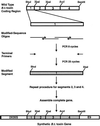Direct evidence for rapid degradation of Bacillus thuringiensis toxin mRNA as a cause of poor expression in plants
- PMID: 9701600
- PMCID: PMC34908
- DOI: 10.1104/pp.117.4.1445
Direct evidence for rapid degradation of Bacillus thuringiensis toxin mRNA as a cause of poor expression in plants
Abstract
It is well established that the expression of Bacillus thuringiensis (B.t.) toxin genes in higher plants is severely limited at the mRNA level, but the cause remains controversial. Elucidating whether mRNA accumulation is limited transcriptionally or posttranscriptionally could contribute to effective gene design as well as provide insights about endogenous plant gene-expression mechanisms. To resolve this controversy, we compared the expression of an A/U-rich wild-type cryIA(c) gene and a G/C-rich synthetic cryIA(c) B.t.-toxin gene under the control of identical 5' and 3' flanking sequences. Transcriptional activities of the genes were equal as determined by nuclear run-on transcription assays. In contrast, mRNA half-life measurements demonstrated directly that the wild-type transcript was markedly less stable than that encoded by the synthetic gene. Sequences that limit mRNA accumulation were located at more than one site within the coding region, and some appeared to be recognized in Arabidopsis but not in tobacco (Nicotiana tabacum). These results support previous observations that some A/U-rich sequences can contribute to mRNA instability in plants. Our studies further indicate that some of these sequences may be differentially recognized in tobacco cells and Arabidopsis.
Figures







References
-
- Adang MJ, Brody MS, Cardineau G, Eagan N, Roush RT, Shewmaker CK, Jones A, Oakes JV, McBride KE. The reconstruction and expression of a Bacillus thuringiensis cryIIIA gene in protoplasts and potato plants. Plant Mol Biol. 1993;21:1131–1145. - PubMed
-
- Adang MJ, Firoozabady E, Klein J, DeBoer D, Sekar V, Kemp JD, Murray EE, Rocheleau TA, Rashka K, Staffeld G, and others (1987) Expression of a Bacillus thuringiensis insecticidal crystal protein gene in tobacco plants. In CJ Arntzen, C Ryan, eds, Molecular Strategies for Crop Protection: UCLA Symposia on Molecular and Cellular Biology, New Series, Vol 46. Alan R. Liss, New York, pp 345–353
-
- Adang MJ, Staver MJ, Rocheleau TA, Leighton J, Barker RF, Thompson DV. Characterization of full-length and truncated plasmid clones and the crystal protein of Bacillus thuringiensis subsp. kurstaki HD-73 and their toxicity to Manduca sexta. Gene. 1985;36:289–300. - PubMed
-
- Bigelow CC, Channon M (1982) In GD Fasman, ed, CRC Handbook of Biochemistry and Molecular Biology, Ed 3: Proteins, Vol 1. CRC Press, Boca Raton, FL, pp 209–243
Publication types
MeSH terms
Substances
Associated data
- Actions
LinkOut - more resources
Full Text Sources
Other Literature Sources

